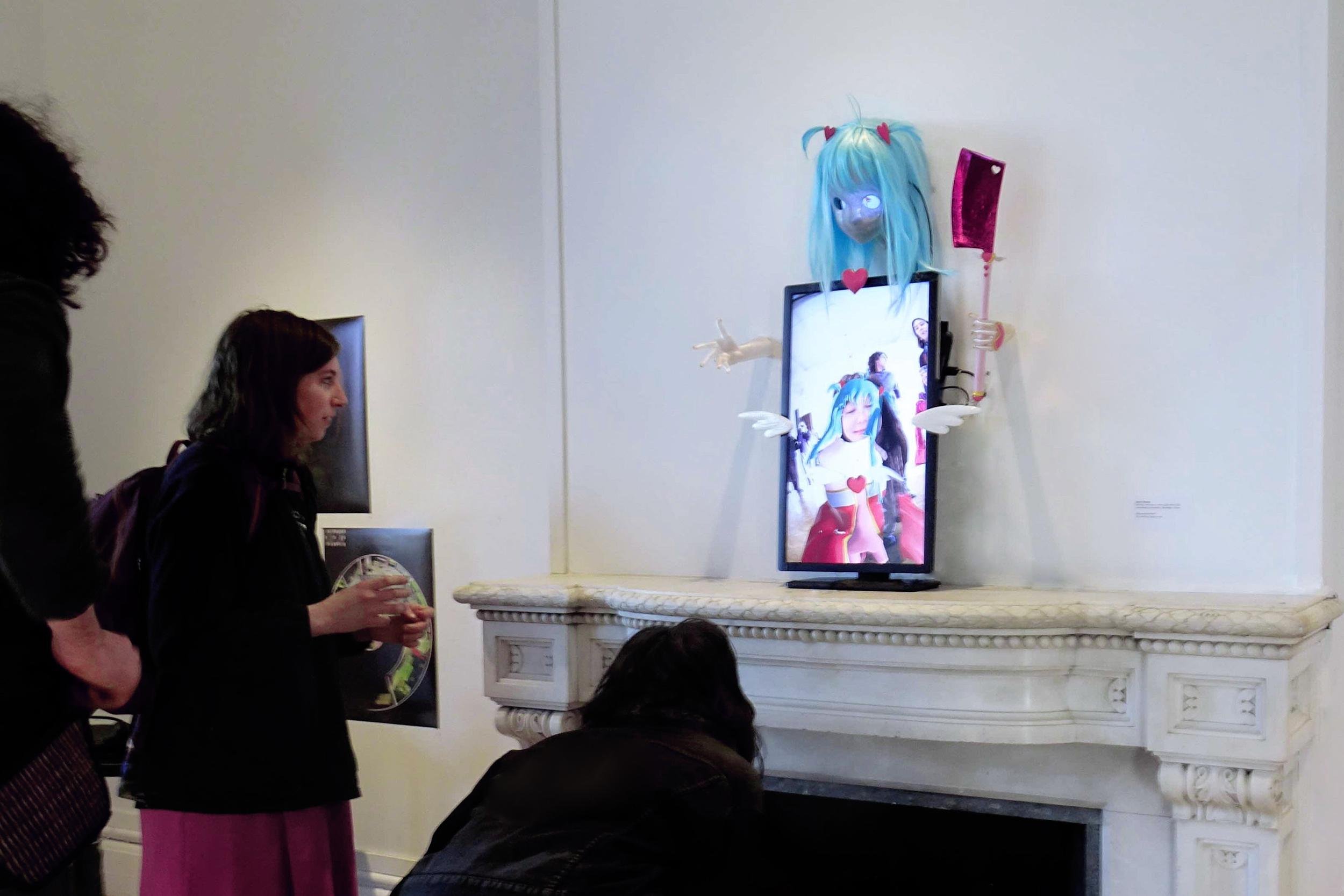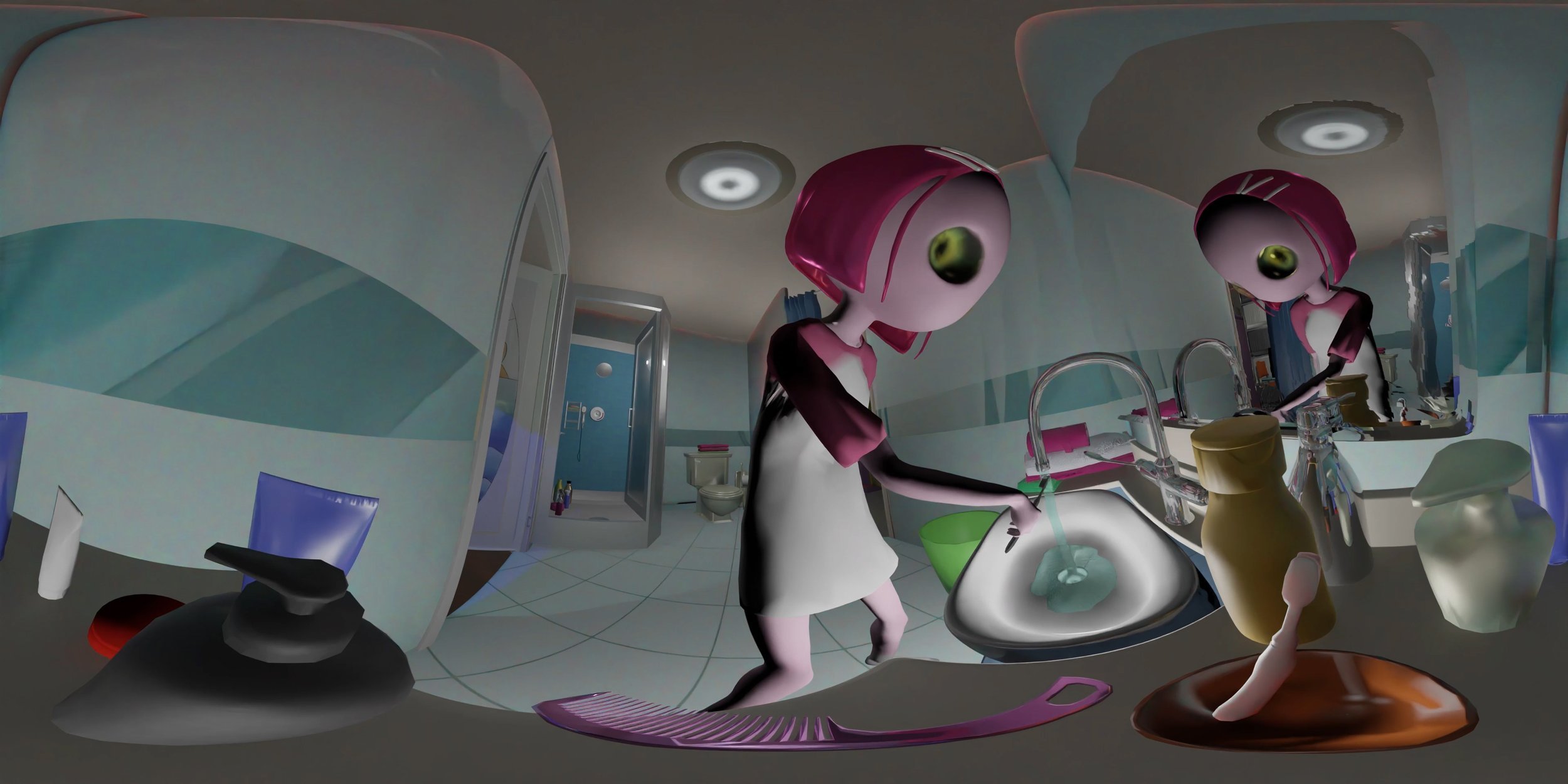Artist Interview: Qinru Zhang
By Cansu Peker
Qinru Zhang has long been frustrated by the way Asian women are idealized in male-centric media — the delicate beauty, the obedient wife, the innocent girl. Wanting to break free from these limiting roles, she initially distanced herself from them entirely, finding comfort in androgynous online avatars. But this detachment became a turning point. It led her to reconsider what femininity truly meant and how she could reclaim it on her own terms. Now, through digital art, Zhang challenges these restrictive narratives head-on, using pink aesthetics, cuteness, and mirrors to tell stories that embrace femininity in all its complexities — sometimes exaggerated, sometimes distorted, but always intentional.
While her online presence once leaned into androgyny as a form of escape, Zhang’s artistic voice leans into hyper-femininity as a form of resistance. Digital space gave her the freedom to exist beyond fixed gender expectations, but art gave her a way to confront them directly. By amplifying and reshaping traditionally "feminine" symbols, she turns them into both critique and reclamation — questioning what society imposes while creating space for a more authentic, multifaceted representation of women. Through dreamy digital environments and striking visual narratives, Zhang’s work challenges the stereotypes she once sought to avoid, proving that femininity, when reclaimed, can be a radical and powerful statement.
We asked Qinru about her art, creative process, and inspirations.
Homecore Frame #4311_2022
Can you tell us about your background as a digital artist? How did you get started in this field?
My background as a digital artist is heavily influenced by my childhood playing dress-up games during the global internet boom in the 2010s. I was always drawn to liminal spaces—where traditions evolve, realities blur, and identities shift. Growing up in different cultural environments, from China, Sweden, to the US, gave me a fragmented sense of identity and allowed me to use digital media to explore transformation in a way that felt truer to my experience.
My time at RISD studying Film/Animation/Video deepened this interest, leading me to experiment with 3D modeling, animation, and creating virtual spaces. Digital art became my primary language because it allows me to create fluid, evolving narratives that blur the boundaries between reality and fiction. In the digital space, I was able to blend historical elements with futuristic aesthetics. Over time, my focus expanded to multimedia storytelling, using 3D techniques, and interactive spaces to examine themes of femininity, digital existence, and perception.
Homecore Frame #3660_2022
Your work challenges traditional representations of Asian women — was there a particular moment that made you want to explore this theme in your art?
There wasn’t a single defining moment, but rather an accumulation of experiences that made me aware of how rigid and contradictory the portrayals of Asian femininity can be. Media often oscillates between hypersexualization and infantilization, presenting women as objects of desire or purity rather than complex individuals. Navigating both Eastern and Western perspectives on gender and self-expression made me question these imposed narratives. My work aims to disrupt these stereotypes by making femininity feel unfamiliar—whether through unsettling aesthetics, distorted avatars, or mechanical elements—forcing viewers to reconsider their perceptions.
For example, my work Momomomomi(2022) is inspired by the voices defining how a girl/woman should be when I grew up. Girls are always associated with the color pink, laces, and cute patterns. Momomomomi(2022) looks at this phenomenon by forcing all audiences to wear a magical-girl-inspired pink, ruffled, girly dress through AR. It discusses the shame and desires around femininity and gender limitations in a patriarchal system, especially in East Asian societies.
Momomomomi, 2022
You’ve mentioned using androgynous avatars online as a way of distancing yourself from limiting labels. How did that experience shape your current artistic voice?
While my online avatars are often androgynous, my work embraces hyper-femininity. Using avatars allowed me to step outside of a fixed gender identity, existing beyond traditional gender markers and physical constraints. Digital space provides a kind of detachment, where representation is fluid—you can be anything without attracting attention or judgment. This freedom allowed me to explore identity on my own terms, without the weight of external expectations.
However, when it came to my artistic voice, I felt the need to create statement pieces that directly challenge limiting narratives. Growing up with identity struggles, I often used digital androgyny as a way to escape rigid gender norms. But through making art, I realized that embracing the extreme expression of femininity—something I once tried to suppress—was a more powerful act of self-assertion. By exaggerating and distorting femininity in my work, I turn it into a site of both critique and reclamation.
Momomomomi, 2022
Femininity in your work is both powerful and complex. How do you personally define femininity, and has that definition evolved over time?
To me, femininity is both a structure and a performance—something inherited, enforced, yet endlessly mutable. Early on, I saw it as a rigid script dictated by cultural expectations, but over time, I began to view it as a tool—one that can be reclaimed, glitched, and rewritten. My work explores this tension by presenting femininity as artificial yet resilient, exaggerated yet constrained. By leaning into hyper-feminine aesthetics, I aim to expose their constructed nature and question whether these systems can be hacked, distorted, or undone altogether.
Over time, the femininity I present in my work has shifted from overt aggression to a more eerie, unsettling presence. For example, The MILF Film (2021), the first piece in my ongoing series The MILF Collection (2021–), depicted femininity as sadistic, plastic, and angry—a direct expression of female rage. In contrast, my most recent works within the series focus less on explicit anger and more on creating an overwhelmingly uncanny atmosphere, decorated with expected feminine elements. Instead of confronting the viewer with violence, these pieces evoke discomfort through subtle distortions, reflecting how femininity itself can be a quietly haunting construct.
The MILF Film_2021
Your use of pink and cute aesthetics is intentional and subversive. How do you balance playfulness with deeper social critique?
Pink and cuteness are often dismissed as frivolous, but they hold immense cultural weight—especially in the way femininity is commodified. I use these aesthetics strategically, luring viewers in with something visually familiar before introducing unsettling distortions. The contrast between softness and discomfort is crucial to my work. It mirrors how femininity is often both celebrated and controlled, something that is simultaneously empowering and restrictive. By pushing cute aesthetics to an extreme—making them uncanny, mechanical, or grotesque—I challenge their perceived innocence and expose the deeper power structures at play.
This approach also reflects my broader interest in subverting cultural symbols. By exaggerating cute aesthetics to the point of discomfort, I force a reconsideration of their meaning—when does "cute" become oppressive, infantilizing, or even grotesque? The tension between attraction and repulsion in my work mirrors how femininity operates in society: it’s often idealized, yet tightly controlled. I want viewers to question why certain aesthetics are deemed harmless or trivial, and whether that perception is itself a form of power.
The MILF Bot_2022
Mirrors appear often in your work — what do they symbolize for you?
Mirrors represent both reflection and distortion. They can be a tool for self-exploration, but they also warp what we see, reminding us that perception is never neutral. In my work, mirrors symbolize the tension between self-perception and external expectation—how we construct our identities while also being shaped by the gaze of others. They create a space where reality unravels at the edges, mirroring how femininity and digital identity exist in a constant state of performance. Just as digital identities can be fluid and self-curated, mirrors offer a sense of agency over one's reflection, yet they also reinforce external ideals. In this way, mirrors become metaphors for the way technology mediates self-image, blurring the boundaries between authenticity and construction.
Homecore_2022
You reclaim and redefine femininity through digital art. What are some of the biggest misconceptions people have about feminine aesthetics?
One of the biggest misconceptions is that femininity, especially when hyper-visible or aestheticized, is inherently shallow. There’s an assumption that if something is pink, delicate, or playful, it cannot also be subversive or intellectual. My work challenges this by embracing femininity in its most extreme forms—hyper-polished, exaggerated, even mechanical—while revealing the underlying tensions of control and autonomy. Another misconception is that feminine aesthetics must either be wholly embraced or completely rejected. I’m more interested in occupying the space in between, where these aesthetics can be both a site of critique and a means of self-possession.
Feminine aesthetics are often treated as binary—either complicit in mainstream ideals or entirely rebellious. I reject that dichotomy. Instead, I see hyper-feminine aesthetics as a means of both subversion and self-possession, a way to inhabit and distort expectations simultaneously. This in-between space is where transformation happens—where femininity is neither a passive identity nor a simple rejection, but something fluid, unsettling, and powerful in its contradictions.
The MILF Head_2022
What do you hope audiences take away after experiencing your work?
I want viewers to feel a sense of both familiarity and unease—to recognize something they think they understand but see it in a new, unsettling way. My work isn’t about providing answers but about creating fractures in existing narratives, allowing space for new interpretations. If a viewer walks away questioning their assumptions about identity, beauty, or digital existence, then I’ve achieved what I set out to do.
I also hope my work evokes an emotional response—whether it's discomfort, nostalgia, or something harder to name. Sometimes, the most impactful art isn’t about analysis but about a lingering, almost subconscious shift in perception. If viewers leave feeling slightly disoriented, questioning what felt "off," then I know I’ve disrupted something worth re-examining.
What else fills your time when you’re not creating art?
I spend a lot of time writing—it helps me process ideas before they take visual form. I also love visiting museums and galleries, where I can disconnect from digital overload and absorb art in a tactile way. When I need a reset, I take long walks in the city. These quiet, in-between moments are often when my best ideas emerge. They remind me that inspiration doesn’t always come from screens or structured research but from the gaps in between, in moments of stillness and quiet observation.
Pinkcore_Poster_34"x17"_2022






















